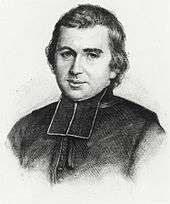
François Caret
François d'Assise Caret, SS.CC., (born François Toussaint Caret; 4 July 1802 – 26 October 1844) was a French Catholic priest of the Congregation of the Sacred Hearts of Jesus and Mary, a religious institute of the Roman Catholic Church.
Life
François d'Assise Caret was born 4 July 1802 in Miniac-sous-Bécherel (Ille-et-Vilaine). He was already a priest by 1829, when he became a professed member of the Congregation of the Sacred Hearts of Jesus and Mary. In February 1834, he sailed from Bordeaux for Valparaiso with Father Honoré Laval.
Advised by one Captain Mauruc that Protestant missionaries had not yet reached the Gambier archipelago, they took passage on the Peruvian, out of Boston, and arrived 8 August on Akamaru, where they found a representatives of the London Missionary Society already established. Caret and Laval established a thriving mission and planned to expand their work to Tahiti.
They arrived in the Kingdom of Tahiti in February 1836, where the American consul, Moerenhout provided them shelter. Born in Belgium, Moerenhout worked for a time in Valaparaiso for the Dutch consul, before taking ship for Tahiti as supercargo with the additional title of French consul. He arrived there in 1829 and made a fortune selling contraband run, gin, and brandy which Queen Pōmare IV had banned on the advice of British missionary George Pritchard. On his way back to France in 1834, Moerenhout stopped in Boston, and subsequently returned to Tahiti with the title Consul of the United States. The British considered him a secret agent for King Louis Philippe I and the Jesuits.
Caret
The caret /ˈkærət/ is an inverted V-shaped grapheme. It is the spacing character ^ in ASCII (at code point 5Ehex) and other character sets that may also be called a hat, control, uparrow, or less frequently chevron, xor sign, to the power of, pointer (in Pascal), or wedge. Officially, this character is referred to as circumflex accent in both ASCII and Unicode terminology (because of its historical use in overstrike), whereas caret refers to a similar but lowered Unicode character: U+2038 ‸ CARET. Additionally, there is a lowered variant with a stroke: U+2041 ⁁ CARET INSERTION POINT.
The caret and circumflex are not to be confused with other chevron-shaped characters, such as U+028C ʌ LATIN LETTER TURNED V or U+2227 ∧ LOGICAL AND, which may occasionally be called carets too.
Origins
Proofreading mark
The caret was originally used, and continues to be, in handwritten form as a proofreading mark to indicate where a punctuation mark, word, or phrase should be inserted in a document. The term comes from the Latin caret, "it lacks", from carēre, "to lack; to be separated from; to be free from". The caret symbol is written below the line of text for a line-level punctuation mark such as a comma, or above the line as an inverted caret (cf. U+02C7 ˇ CARON) for a higher character such as an apostrophe; the material to be inserted may be placed inside the caret, in the margin, or above the line.
Caret (disambiguation)
Caret may refer to:
See also

Caret (software)
CARET (Computerized Anatomical Reconstruction Toolkit) is a software application for the structural and functional analysis of the cerebral and cerebellar cortex. CARET is developed in the Van Essen Laboratory in the Department of Anatomy and Neurobiology at the Washington University School of Medicine in St. Louis, Missouri.
CARET is a free, open-source application distributed in both binary and source formats under the GNU General Public License. CARET runs on FreeBSD, Linux, Mac OS X, and Microsoft Windows.

Image of CARET main window with functional and foci data on surface
Image of CARET main window with functional and foci data on surface
CARET's capabilities
François
François (French pronunciation: [fʁɑ̃.swɑ]) is a French masculine given name and surname, equivalent to the English name Francis.
People with the given name

François (album)
François is the French-language debut album by Desireless, released in 1989. The single "Voyage, voyage" was a chart topper in many European and Asian single charts and sold over five million copies.
Track listing
2001 CD re-release track listing
Label: Choice Of Music Catalogue number: 200 105-2
Podcasts:

